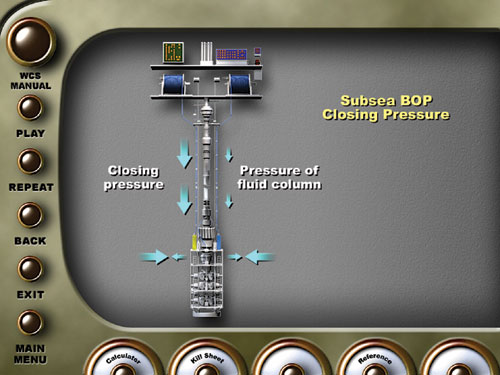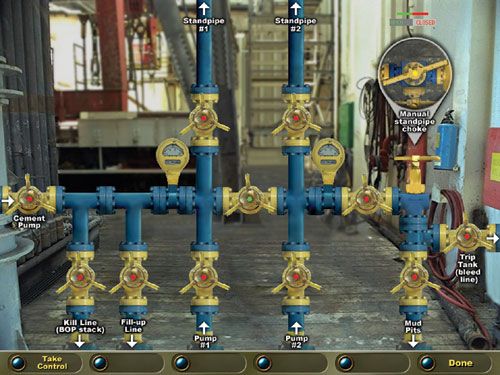MMS regulations impact worldwide training and certification
OFFSHORE REPORTMMS regulations impact worldwide training and certificationMMS to cease well control and production safety certification – Interactive computer-based training helps companies comply
This article describes some of the MMS regulations with which companies must comply and briefly explains their ramifications. It presents the obstacles companies will encounter in seeking compliance, and ends with an available, proprietary, training solution. Companies Face Training Compliance Requirements MMS requires competency in well control and production safety, and with the October 15, 2002, deadline approaching, companies are scrambling to understand the regulations and determine their best course of action. Glenn Shurtz, president of Well Control School, said that oil companies must be aware of the monumental task ahead of them. "Just getting certification will no longer be enough. Some companies aren’t aware of the implications of these new regulations and what this will mean to their training programs." Shurtz noted, "Many larger companies have expressed concern for how to measure competency within their own company’s personnel worldwide. To add to their concern, they do not know where to begin to verify other companies’ personnel hired for contract work," Fig. 1.
MMS seeks assurance that employees and contractors can not only pass the written test, but can also perform the necessary skills of well control and production safety. Well control means drilling, well completion and well servicing (snubbing, coiled tubing and wireline) operations. Production safety means production operations, as well as the installation, repair, testing, maintenance, or operation of surface or subsurface safety devices. MMS Subpart O regulations clearly identify and mandate what must be implemented concerning training, record keeping and training plan audits:
Although in the past a certificate indicated that personnel had successfully completed training, it became evident that passing the test did not mean the individual could perform the actual skills and tasks required on the job. After many accidents stemming from operator error, MMS recognized that more stringent accountability was required to prove core knowledge of the materials and also core competency of the skills needed to perform the job duties.
MMS has set a clear deadline for the industry to have a plan ready to implement by October 15, 2002. Until the deadline, the industry can continue to use existing approved and accredited courses and schools for MMS certification. After this date, however, the burden of accountability will fall on the individual companies to create and implement a plan for proving competency of personnel and contractors.
MMS has outlined specific requirements for creating a verifiable plan, which state that companies must verify that their employees understand and can perform the assigned tasks on the job site. The plan must specify type, method(s), length, frequency and content of the training, and it must include procedures for: 1) training; 2) evaluating the training plan; 3) verifying competency; and 4) assessing training frequency needs, record keeping and internal audit procedures.
MMS allows companies to use alternative training methods that may include computer-based learning, films or their equivalents. Appropriate demonstration and "hands-on" training must reinforce this training. Once again, MMS is stressing the need for verifying knowledge and skill assessment so that personnel can perform the required duties safely on the job site.
Companies must provide periodic training, establish procedures to verify adequate retention of knowledge and skills, and ensure that contractors’ training programs provide for periodic training and verification.
Training system audits will compare the company’s training program against this subpart. Companies must be prepared to explain their overall training program and produce evidence to support their explanation. MMS may conduct interviews at either onshore or offshore locations to inquire about the types of training that were provided, when and where this training was conducted and how effective the training was for the individual. MMS may also conduct testing to evaluate an individual’s knowledge and skill level in well control and production safety. Hands-on production safety, simulator or live well testing will be used to evaluate employee and/or contract personnel competency. If the MMS finds that the company’s training program is not in compliance, it may initiate one or more of the following enforcement actions. It can issue an Incident of Noncompliance; require the company to revise and submit to MMS the training plan to address and identify deficiencies; assess civil / criminal penalties; or initiate disqualification procedures. How Companies Can Prepare Operators and service companies face two issues: 1) How to implement consistent training to verify knowledge and skill levels worldwide; and 2) How to verify other companies’ compliance with the new MMS regulations when selecting contractors. These concerns have led to much uncertainty about the future of traditional training programs. MMS wants to raise the level of training. The importance of identifying areas through documentation where an employee or contractor needs remediation is the key to MMS’s new Subpart O regulations. Because just receiving a certificate may no longer suffice, the key is to show and document that the personnel know all the topics and skills required to demonstrate competency. Passing a written examination is very different from passing a hands-on exercise, demonstrating real-world routine and emergency scenarios. Well Control School (WCS) in Harvey, Louisiana, has solutions for addressing these new regulations. Its proprietary System 21 Well Control and Production Safety Systems Training programs exceed MMS Subpart O regulations, to ensure competency of personnel. The system is the only interactive computer-based training and certification system approved, to date, by MMS for well control and production safety systems. The programs satisfy the requirements mandated by the new federal regulations to develop a training plan, verify competency and frequency of oilfield training, and document and maintain records for operator personnel and its contractors. It can be a company’s complete training plan. In a letter addressed to WCS, Joseph R. Levine, chief of operations analysis of the Minerals Management Service, wrote: "Your letter requested review and approval of your ‘System 21’ training program for drilling, well completion / well workover, and well servicing activities under 30 CFR Part 250, Subpart O regulations. This program includes both surface and subsea options for permanent and traveling schools. As part of this approval, Mr. Wilbon A. Rhome of the Mineral Management Service conducted an initial onsite evaluation of your company’s program and found it to be in compliance with the program submitted. Therefore, WCS’s ‘System 21’ training program is approved." The program’s extensive reporting system provides proof of competency and verifies that more than 2,000 topics and skills have been administered and assessed. One of the benefits of the program is that it logs not only an employee’s strengths, but also his weaknesses, providing a plan for further areas where improvement and remediation may be necessary. The system contains self-paced programs for well control and production safety systems. Well Control is a self-contained interactive training and simulation program providing for certification in drilling, well completion / well workover, well servicing (snubbing, coiled tubing, wireline) and subsea. Production Safety Systems Training (PSST) is a self-contained interactive / simulation program providing required T-2 training certification. These programs are available and easily implemented at the rig site or platform, offices, in-house schools or at any of the WCS training locations. The system helps reduce overall training costs by as much as 50% by eliminating expenses for travel, hotel, meals, overtime and relief personnel, Fig.2.
The Well Control program contains more than 2,000 topics and skills, thus providing high-level training, testing, simulation and overall employee competence to the oil/gas industry. Interactive tasks and role-playing familiarize learners with well-control concepts, emphasizing correct procedure and teamwork. Computer graphics dramatically depict downhole conditions such as deepwater or horizontal drilling. As students complete each module, skill levels are recorded and progress reports are generated as the users work toward obtaining certification. The instructional design of System 21 ensures comprehension of key points, preventing a student from moving on until the material is completely understood. Students are pre- and post-tested on all modules, plus they are given a certification test. If a student misses a question, he returns to the appropriate section for instruction and is then re-asked the question. Random test questions and answers for every module are administered to validate competency in each area covered. Upon completion of either Well Control or Production Safety Systems Training, a full student report is issued. The system allows full disclosure of a student’s performance at the touch of a button. This includes the certification test score, topics and skills covered, as well as custom reporting on those areas where students missed questions or had to make repeated attempts on a simulator. This extensive reporting system provides proof of competency and verifies that more than 2,000 topics and skills have been administered and assessed. Compliance Is Mandatory And Fast Approaching As the deadline for compliance with the new MMS Subpart O regulations approaches, only one thing is for certain – companies must comply. What method they elect to use to comply with the new regulations will determine not only how their training programs will be implemented, it will also determine what business opportunities lie ahead. Because the burden of proof for companies encompasses not only employees, but contract personnel as well, large companies will be more inclined to select contractors who follow their own guidelines for training. The companies hope that – by creating a standard method of training and maintaining records – they can set the example for the industry in providing diligent and consistent training worldwide. This will be their only way to feel confident that contractors are trained and their skills properly assessed in well control and production safety. To obtain a copy of the new Minerals Management Service
Federal Register Vol. 65, No. 157 Subpart O regulations or information about System 21 Well Control and
Production Safety Systems Training, please send your request to staff@wellcontrol.com or visit
www.wellcontrol.com.
Acknowledgment This article was prepared with the assistance of Dennise Sauvage, marketing manager for Well Control School, a subsidiary of RPC, Inc., Harvey, Louisiana. |
- Applying ultra-deep LWD resistivity technology successfully in a SAGD operation (May 2019)
- Adoption of wireless intelligent completions advances (May 2019)
- Majors double down as takeaway crunch eases (April 2019)
- What’s new in well logging and formation evaluation (April 2019)
- Qualification of a 20,000-psi subsea BOP: A collaborative approach (February 2019)
- ConocoPhillips’ Greg Leveille sees rapid trajectory of technical advancement continuing (February 2019)




